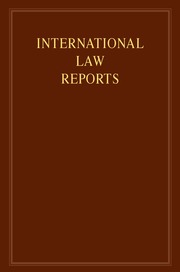No CrossRef data available.
Article contents
Dispute Concerning the Course of the Frontier between BP 62 and Mount Fitzroy (Argentina/Chile.)
Published online by Cambridge University Press: 01 January 2021
Abstract
Arbitration — Successive arbitrations — Status of second arbitration tribunal — Second tribunal's jurisdiction confined to matters within the jurisdiction of the first tribunal — Whether second tribunal possessing independent status — Effect of award of second tribunal — Res judicata
Arbitration — Evidence — Maps — Reliability — Different uses which parties to arbitration made of maps — Other evidence before tribunal — Estoppel — Acquiescence
Arbitration — Procedure — Closing submissions of parties — Whether parties able to modify submissions — Use of expert by tribunal — Whether tribunal delegating power to expert — Finality of award — Party seeking revision of award on grounds of error — Powers of tribunal — Distinction between errors of fact and errors of law
International tribunals — Arbitration tribunal established by two States to determine boundary — Status — Procedure — Evidence
Lakes and landlocked seas — Lakes — Lake as part of international boundary — Water-parting — Use as boundary — Distinction between continental water-parting and local water-parting
Territory — Boundaries — Principles of delimitation — Use of orographical and hydrographical techniques — Maps — Relevance — Importance in showing State practice — Water-parting as boundary — Whether boundary could cross glacier — Effect of movement of glacier — Estoppel — Acquiescence — Administrative acts in disputed territory — Interpretation of earlier arbitration award — Effect of changed knowledge of location of water-parting since original award delivered — Argentine — Chile boundary
- Type
- Case Report
- Information
- Copyright
- © Cambridge University Press 1999




